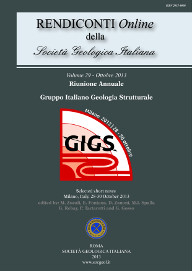
Geological map of the central sector of the Catena Costiera (Northern Calabria)
Francesco Filice (a), Francesca Liberi (b), Daniele Cirillo (b), Luca Pandolfi (c), Michele Marroni (c) & Eugenio Piluso (a)
(a) DiBEST - Department of Biology, Ecology and Earth Sciences, University of Calabria , via Ponte Pietro Bucci, cubo 25b, 87036, Rende (CS), Italy. E-mail: francesco.filice@unical.it
(b) Di.S.P.U.Ter - "G.d'Annunzio" University of Chieti-Pescara, via Dei Vestini 31, 66013 Chieti Scalo (CH), Italy.
(c) Department of Earth Sciences, University of Pisa, via S. Maria 53, 56126 Pisa, Italy.
Volume: 29/2013
Pages: 55-58
Abstract
Geological mapping of the central sector of the Catena Costiera (Northern Calabria) has been carried out on an area of about 260 km2, together with the structural analysis of the units affected by the Alpine tectonics. The Geological Map of the Central Catena Costiera area (Northern Calabria) is a 1:25.000 scale map realized on the base of an original fieldwork made on 1:10.000 scale. The collected data allow to reconstruct the tectonostratigraphy of this segment of the chain and to introduce important geological constraints for the geodynamic evolution and the regional geology of the area.
Two HP-LT metamorphic grade ophiolitic units were distinguished on the base of their stratigraphic and petrological features: the Mongrassano and Cozzo Cervello units. The latter includes the metapelitic-metarenaceous rocks previously attributed to the Bagni unit as defined by Dietrich and Scandone (1972). The ophiolitic units show a complex tectonometamorphic evolution that can be explained in a context in which the oceanic-derived rocks underwent subduction and exhumation as tectonic slices inside an accretionary wedge with a top-to the W sense of tectonic transport. The continental-derived rocks of the Calabride element lie onto the ophiolitic units. They are constituted by Variscan medium and high-grade metamorphic rocks that escaped the Alpine high-pressure metamorphic event, except for the Castagna unit that lies directly on the Cozzo Cervello unit and display an HP metamorphic and structural overprint.
Finally, middle Miocene-Holocene sedimentary successions, associated to the transtensional tectonics that affected this area from middle Miocene onwards, deposited on top of the orogenic pile.
Keywords
Get Full Text